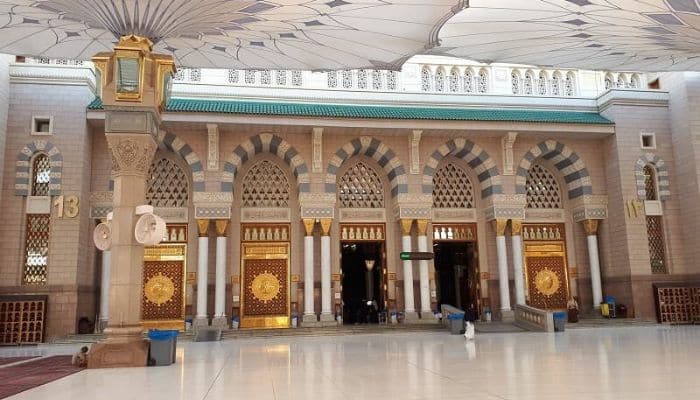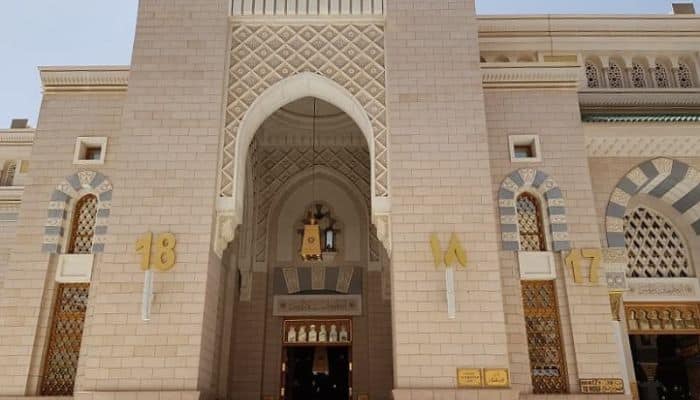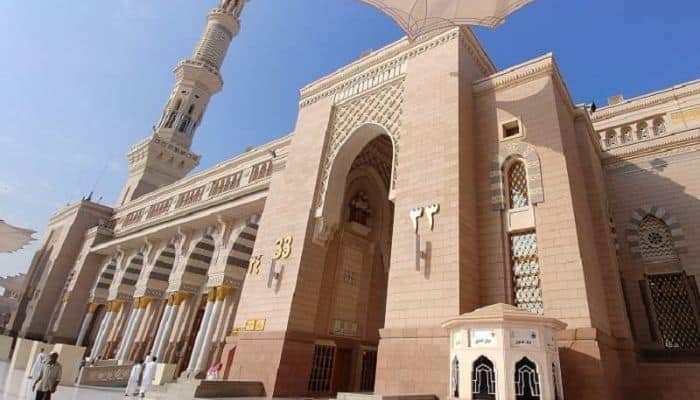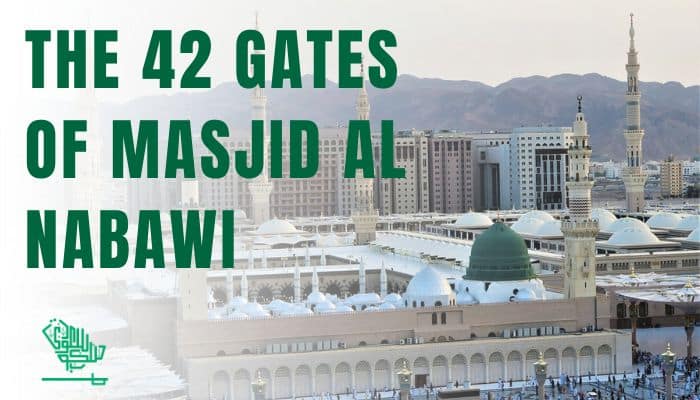At present, there are 42 gates in Masjid al Nabawi. These entrances provide access to both men and women, making it easy for the crowds to enter the main building complex.
The gates vary in terms of size, age, and function. Some date back to the first Saudi expansion and are now part of the modern structure we see today.
Not everyone is aware that there are so many Masjid al Nabawi gates. Read on to learn more about each of these gates and some of their features:
Gates for Men and Women
Gates for Men Only
Certain Masjid al Nabawi gates are reserved for men. These are: 1, 2, 3, 4, 5, 6, 7, 8, 9, 10, 11, 15, 16, 17, 18, 19, 20, 21, 22, 31, 32, 33, 34, 35, 36, 37, 38, 39, 40, 41
Gates for Women Only
There are fewer Masjid al Nabawi gates reserved for women only. These are 12, 13, 14, 23, 24, 25, 26, 27, 28, 29, 30.
Masjid al Nabawi Gates: Navigating Tradition and Convenience
Bab as-Salam(Gate no. 1)

The name means ‘the gate of peace’; this is the largest and most decorated of the Masjid al Nabawi gates. During the mosque extensions, Bab as-Salam was moved within its original line to a more westward location.
Bab-i abu Bakr Siddique (Gate no. 2)

The Gate of Abu Bakr is built northwards and is situated next to the Bab as-Salam. Another name for it is the “Khukha Abi Bakr,” signaling that it was initially a smaller door.
Bab ur Rehmah (Gate no. 3)

This is among the three oldest Masjid al Nabawi gates installed by the Prophet Muhammad (SWS) during his lifetime. It was also called ‘Bab-e-Atika,’ being originally built in front of ‘Atika bint’ Abdullah bin Yazeed’s home.
Bab Hijrah(Gate no. 4)

Built-in 1985 CE, this is named the ‘Gate of Migration’. It’s a twin arched gate in the southern wall, made during the Second Saudi Expansion of Masjid al Nabawi. The name was in memory of the Hijrah from Makkah to Medina in 622 CE.
Bab Quba (Gate no. 5)

This Gate is named after the small village of Quba, which was initially on the outskirts of Medina, around 5 kilometers away from Masjid al Nabawi. It’s a triple-arched gateway on the south-western flank of the King Fahad bin Abdulaziz block.
Bab Malik Saud (Gate no. 7, 8, 9)

The Gate of King Al-Saud has seven portals and is situated in the King Fahad expansion part of the Masjid. It also has one of Masjid al Nabawi’s six tallest minarets.
Bab-i Imam Bukhari (Gate no. 10)

This Gate was named for Imam al-Bukhari, one of history’s most esteemed and important hadith scholars. It’s on the Masjid’s Western flank and allows people into the library or Maktab Masjid Nabawi.
Bab ul-Aqeeq (Gate no. 11)
This Gate is on Masjid al Nabawi’s Western side and gets its name from the Wadi al-Aqeeq in Medina. This valley is where many prominent companions lived.
Bab Sultan Abdul Majeed (Gate no. 12, 13, 14)

Situated on the North-Western flank of the Malik Fahad expansion, this Gate has one minaret, five small portals, and two large portals.
Bab-i Umar ibn al-Khattab (Gate no. 16, 17, 18)

The Gate was named for Umar bin Khattab; it is on the northern wall and opens into the library.
Bab e Badr (Gate no. 19)

This is a single portal gate, with a verse from Surah al-Hijr inscribed in marble above it. The verse reads, “Enter within in peace (be safe and secure)” (15:46).
Bab-i al-Malik Fahad (Gate no. 20, 21, 22)

The Gate’s name, King Fahad, is after Malik Fahd bin Abdulaziz al-Saud. It’s the Masjid al Nabawi’s main entrance from the northern side. There are a total of seven doors and five domes here, flanked by two minarets.
Bab-i Ohad (Gate no. 23)

This Gate’s name is for the Uhud Valley or the Uhud Mountain, where the Muslims fought the Battle of Uhud. It’s among the smaller Masjid al Nabawi gates, with traffic regulators used only when there’s a high crowd concentration.
Bab-i Uthman ibn Affan (Gate no. 24, 25, 26)
This is another of the Masjid al Nabawi gates that takes its name from an esteemed Companion of the Prophet (SWS). Here, the name comes from Uthman ibn Affan, also known as Uthman Ghani. It’s one of the seven most enormous Masjid al Nabawi gates.
Bab Ali ibn Abi Talib (Gate no. 28, 29, 30)
Situated in the Eastern wall, this is also one of the seven largest Masjid al Nabawi gates. Its name is after Hazrat Ali ibn Abu Talib (RA), the first cousin and son-in-law of the Prophet Muhammad (SWS).
Bab-i abu Dhar Ghaffari (Gate no. 31)
This Gate’s name is after the companion Abu Dhar (RA), one of the first to embrace Islam. It has one portal, making it one of the smallest Masjid al Nabawi gates.
Bab Imam Muslim (Gate no. 32)

This Gate gets its name from the esteemed Hadith scholar Imam Muslim, originally from Nishapur. It’s among the smaller Masjid al Nabawi gates.
Bab Malik ‘Abdulaziz (Gate no. 33, 34, 35)

This is among the largest Masjid al Nabawi gates, having two large portals, five smaller ones, and a minaret on the southmost side.
Gate no. 36
While there is no official name for this Gate, this is one of the access points to the Rawdah Rasool.
Bab-i Makkah (Gate no. 37)

The Gate of Makkah is situated on the Southern wall of the Malik Fahad expansion. It’s located in the direction of Makkah and is one-half of an identical pair. The design still conforms to the first expansion’s architectural patterns.
Bab-i Bilal (Gate no. 38)

The Gate of Bilal was named for Bilal ibn Rabah al-Habashi, most commonly known for being the first Muazzin. It has four access portals now, but it used to be one of the smaller Masjid al Nabawi gates in 639 CE.
Bab-un Nisa (Gate no. 39)

The Gate of Women was installed during the time of Caliph Umar bin Khattab. It was intended for women to enter and leave the mosque compound. Everyone used it then, but it was exclusively for ladies during the rule of Umar bin Abdul Aziz. Today, it’s mostly reserved for men and is among the Masjid al Nabawi gates closest to the burial site of the Prophet Muhammad (SWS).
Bab Jibrīl (Gate no. 40)

Also called the Bab un Nabi, this Gate symbolizes the point where the Angel Jibril entered the Prophet’s (SWS) abode.
Bab-i Baqi (Gate no. 41)

This is the closest Masjid al Nabawi gate to the resting place of the Prophet (SWS). It has one minaret and two Arabic inscriptions.
Bab-ul Aiymah or Bab ul-Janayez (Gate no. 42)

Also called the “Gate of the Imams,” this smaller Gate allows access to the Rawdah Rasool. It is usually a gate for Imams and is close to the Mihrab Uthmani.
Photo Source: All photos’ owners are unidentified. We fully respect and acknowledge the rights of content creators and photographers. If you recognize any uncredited images or have concerns about their usage, please reach out to us immediately for proper attribution or removal. We are committed to upholding ethical practices regarding image usage and intellectual property rights.

Rosa Gardens is a writer at Saudi Scoop, dedicated to delivering insightful and engaging content. With a keen eye for detail and a passion for storytelling, Rosa covers various topics that inform and inspire readers.




